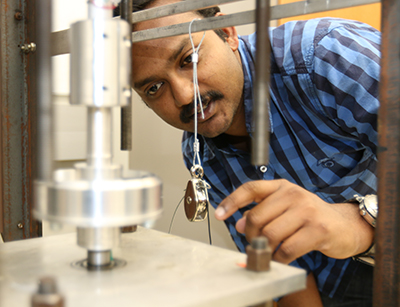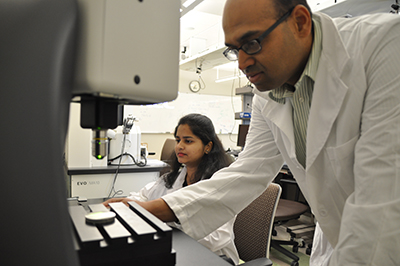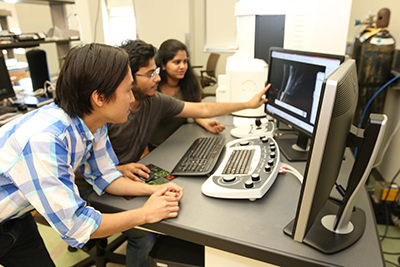Researchers in the Department of Industrial and Systems Engineering at Texas A&M University are working to make life easier through research that is revolutionizing society.
The long awaited day of 3-D printed replacement body parts may be just around the corner; along with the day of producing metal more quickly and efficiently, thanks to the work of those in the advanced manufacturing field.

A team of researchers comprised of Dr. Satish T.S. Bukkapatnam, Dr. Alaa Elwany, Dr. Dinakar Sagapuram and Dr. Shiren Wang, is working in four core areas: precision and smart manufacturing, additive and hybrid manufacturing, nano and bio manufacturing, and manufacturing enterprise systems.
“During the past two years, the core members of this group have together secured or brought with them seven federal grants to address the contemporary challenges in advanced manufacturing,” said Bukkapatnam, Rockwell International professor in industrial and systems engineering.
These grants fund the research that takes place in state-of-the-art facilities such as the advanced manufacturing facility, part of the Texas A&M Engineering Experiment Station (TEES) Institute of Manufacturing Systems (IMS).
“This facility promotes cutting-edge interdisciplinary research,” said Bukkapatnam, who serves as the director of IMS. “There are four colleges working together in here. They are engineering, architecture, veterinary medicine and science, as well as the Texas A&M Health Science Center.”
Working together with 30 other faculty members across the college of engineering, these researchers are changing society.
Securing Our World
With a rise in competition and security perceptions globally, the need for smart manufacturing and continuous, round-the-clock monitoring of quality and integrity of our security measures is necessary for the survival of modern engineering systems. Bukkapatnam’s team has identified these needs in precision and nano-manufacturing processes for making personalized and custom parts, particularly in the medical, transportation and defense sectors.

“Sensor technologies are becoming available to interrogate any aspect of modern engineering systems at every conceivable scale of a product, process or system,” Bukkapatnam said.
These sensors have the capability to capture a variety of information on the product, process or system. This poses a new challenge: connecting the large-amounts of sensor data to bring significant improvements to the design and operations of these engineering systems.
“The core of this research is to harness information on the nonlinear stochastic dynamics and the emergent behaviors,” Bukkapatnam said. “This includes chaos, self-organization and long-range dependencies in the form of customized multi-scale representations and formal models, and to track features separated from these models to monitor and control the quality and integrity of complex systems.”
Bukkapatnam and his team have now expanded this research to the world of cyber manufacturing. That is, creating a virtual manufacturing set-up that has the ability to translate the client’s needs into a product or process that can be implemented immediately. They are working collaboratively with support from the National Science Foundation.
Printing for the Future
Focused on modeling, analysis and control of next-generation manufacturing processes with special emphasis on additive manufacturing, known as 3-D printing, Elwany is working to improve the quality of metallic parts produced using 3-D printing.
“The main contribution of my research is to enable the production of 3-D printed parts with high levels of geometric complexity and unique physical and mechanical properties that are simply not possible or extremely expensive to produce using traditional manufacturing methods, such as machining or injection molding,” Elwany said.
Three-dimensional printing will change the way the world knows the manufacturing industry in art, construction, customization, energy use, medicine, product availability, sciences and waste reduction. Elwany is currently working with NASA and the Air Force Office of Scientific Research to test his methods in the space and defense industries. The research today will improve the products produced and make them fully functional by the end user.
Improving Lives
With more that one million people going through
surgery to repair the tear in their meniscus every year, Wang is exploring the additive manufacturing of synthetic knee cartilage for meeting biomedical requirements. By using 3-D printing, Wang is looking for solutions to eliminate the risk of pathogen transmission, immune rejection and tissue mismatch for patients facing meniscus transplantation surgery.

“First, the printed material must be compatible with the environment it is placed in around the knee,” Wang said. “Second, the material must allow the knee to function properly. The leg still needs to be able to kick the ball and run.”
In addition to 3-D printing synthetic materials, Wang developed a way to scale up nanoparticles and create structured forests that improve the performance of energy storage. The discovery of these forests made up of tiny particles could revolutionize the current energy storage technology on the market.
“These nanostructured forests are the future batteries,” Wang said. “They will greatly enhance the performance of energy storage, including cell phone and laptop batteries.”
Wang is working with and funded by the National Science Foundation under the faculty early career development program.
Creating New Ideas
The advanced manufacturing team from Texas A&M and TEES was selected by the White House to lead the new Gulf Coast Regional Advanced Manufacturing Center. The new center is a part of the Clean Energy Smart Manufacturing Innovative Institution, which will be comprised of five regional centers located across the country.
Researchers in the Department of Industrial Engineering are making strides in changing the way manufacturing can easily meet the needs of our instantaneous society, while maintaining a quality end product.
“Manufacturing essentially involves creating products that have value,” Bukkapatnam said. “As the nation engages in various manufacturing initiatives, including additive, smart and nano manufacturing, there is a growing opportunity for the industrial community to engage in fundamental investigations combining physical and data science principles to address major future challenges.”